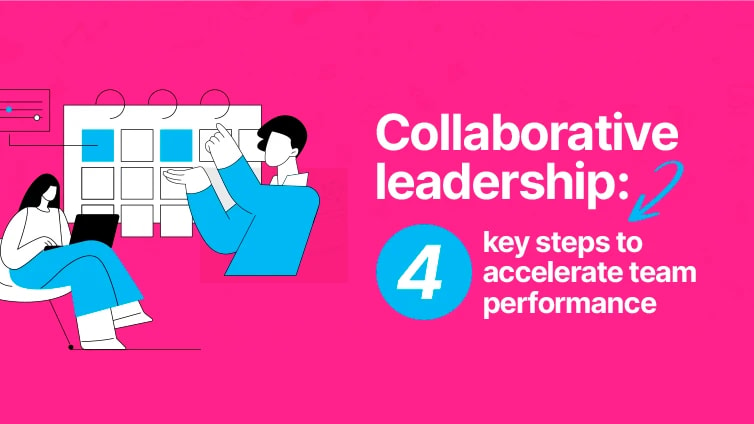Enhance the Future of Work: A guide to efficient change management
Published on July 30, 2025
Enhance the Future of Work: A guide to efficient change management
The challenges faced by companies in their change management process are increasingly numerous and complex. For example, Gartner shows that 54% of corporate teams are still affected by "change fatigue". A McKinsey study also points out that 50% of organizations do not yet feel resilient enough to cope with upheavals or unforeseen events in the future.
Leaders therefore need to put in place a clear and comprehensive strategy to engage all stakeholders in driving change and ensure rapid and effective execution of actions while reducing their costs.
In 10 steps, this guide helps you to design and structure your organization's transformation process, using innovative methods and tools to ensure a smooth transition to agile and resilient practices.
In particular, the ongoing involvement of stakeholders in the change management process is fundamental. McKinsey highlights the correlation between the number of employees involved in the transformation and its improved profitability: for 30% of employees engaged in the company, the return on investment to shareholders increases by 67 points!
Management's priority must therefore be to create a culture of engagement within the company, fostering active and effective collaboration throughout the transformation process.
At each of these stages, the use of all-in-one collaborative tools like the Klaxoon platform is essential to effectively centralize your interactions, engage all your teams in different contexts, and empower them to experiment and innovate at any time, wherever they are. These practices enable companies to grow 3 times faster than others, and to be 5 times more innovative (McKinsey)!


Today, more than ever, the challenges are numerous and complex for companies implementing a change management approach. To be profitable, their managers must not only succeed in engaging all the stakeholders in the transformation but also ensure maximum efficiency and rapidity in the execution of their actions.
Added to this is the constant need to reduce and better anticipate costs. As Gartner confirms, the transformation process in large companies averages at least 2 times the initially estimated cost.
It is therefore essential for decision-makers to develop a comprehensive change management strategy that takes all these factors into account. In this way, they will be able to ensure a smooth transition for their company and remove all the barriers separating it from an agile organization.


An in-depth transformation of working practices requires the commitment of everyone involved in the process.
This step-by-step guide will help you structure your transformation process, and involve all your teams in innovating efficiently and flexibly.
First of all, it's important to note that change management is no longer a one-off response to a need to transform practices, as was the case several years ago. It is now a process of constant evolution, integrated into organizations over the long term and embedded in their corporate culture.
At the root of such an approach lies a concrete vision, based on a clear diagnosis of the need for change. The first step is therefore to establish this diagnosis and to align yourself with the objective to be achieved at the end of the transformation. This involves approaching the need for change from several angles and analyzing the possible impacts of transformation actions on your business, your working practices, and your corporate culture.
Once the need for change has been defined, you need to build a clear vision around it and communicate it to all levels of your organization. What results do you expect if the transformation goes according to plan, and delivers a solution to your need? Your vision needs to be complete and convincing so that the whole organization is fully aware of the process.
Above all, you need to highlight the real need for change and give it meaning. If it doesn't acquire the hoped-for legitimacy with your peers and teams, they risk developing "change fatigue", i.e. a weariness linked to a state of constant change with no real purpose in their eyes. A survey by Gartner shows that 54% of teams in their company suffer from this, at a time when their resilience and adaptability are being overstretched.
At this stage, you should also think about optimizing your budgets, and project a sustained pace for your transformation actions. The reason is simple: in today's fast-moving environment, it's important to get the first results quickly, so you can iterate and adjust your approach.
But beyond the need for responsiveness and adaptation, this "need for speed" trend also represents a real competitive advantage. According to McKinsey's The State of Organizations 2023 study, companies that adopt a faster pace of transformation grow 3 times faster than others and are almost 5 times more innovative.
According to McKinsey, even today, half the companies surveyed believe they are not fully prepared to face upheavals or disruptions in the future.
And yet, building a resilient work environment in the face of change is closely linked to the performance of your transformation initiatives. Analyses carried out after the financial crisis of 2007 to 2009 (The State of Organizations 2023) show that companies considered to be the most resilient at that time implemented actions that were 20% more profitable than others. Ten years later, in 2017, this profitability even reached 120% for some of them!
How can this be explained? It's because adopting a resilience mindset enables you to create a real virtuous circle. The more your organization can adapt and absorb the consequences of change at a given moment, the faster and more effectively it will do so in subsequent stages, and the greater its growth will be in the long term.
But we mustn't forget that an organization's resilience is first and foremost generated by the people within it.
From the outset, it is therefore essential to provide them with a workspace that reflects this commitment to resilience. This environment must enable everyone to work seamlessly at any time, from anywhere. This, for example, is what all-in-one platforms like Klaxoon's do, equipping the people involved with visual collaboration tools and proven methods to develop their autonomy and capacity for innovation, with full responsiveness.


The Klaxoon platform offers a structured collaborative environment, to develop your change management actions with efficiency (here with the Transformation Map template).
How many people do you need to involve as key players in your change management process? And who should they be?
According to another McKinsey study, companies with at least 7% of employees engaged in the transformation process see a 2-fold increase in the profitability of their actions. Beyond this 7% threshold, the same study reveals a direct correlation between the number of people involved and the profitability gains generated. In particular, for every 30% of employees involved, the profitability of the transformation increases by 67 points.
This means that the more people involved, the better.
What's more, the most relevant stakeholders for driving change forward can be found at all levels of the company, and even externally. It's also important to understand that there are many ways to be involved as a stakeholder: decision-making, implementation of transformation actions at the departmental or team level, etc.
Similarly, it can sometimes be a good idea to identify "champions of change" within your organization. The aim is to create a network of ambassadors with a wide range of experience and expertise, who can bring change initiatives to the collective.
However, to complement the work of these ambassadors and initiate real adoption at scale, the exemplary role of top management remains essential. Leaders must be the first actors of change in their organization and lay the foundations through their own day-to-day actions to inspire all their teams.


According to Forbes, 60% of business transformation initiatives fail if their leaders do not use appropriate methods.
In fact, these methods act as levers for deploying change at scale, within a framework common to all. In a context where you are seeking to develop your organization's resilience in the face of change, agile methods and tools can therefore prove invaluable in accelerating your progress and generating results.
Agile work methods here include those derived from the agile framework (Scrum, Kanban,...), but also more broadly efficient, visual, and easy-to-use work methods. More than a hundred of these ready-to-use methods are available in Klaxoon's template library: methods to facilitate ideation, feedback exchange, flexible project management, etc.
As we have seen, change management involves numerous stakeholders from all levels of the company. Sometimes, they even come from outside. In particular, the ambassadors chosen to accelerate the transformation movement at scale need to come from a variety of backgrounds, with the aim of effectively engaging and inspiring all teams.
The problem? This can lead to difficult cross-functional collaboration and communication. With so many people and organizational layers involved, it can quickly become very complex to transmit information to everyone smoothly, and above all to get feedback from the field.
To considerably simplify all your exchanges, virtual collaborative spaces can help you centralize all information in a single location, which can be adapted to face-to-face as well as remote, synchronous as well as asynchronous, and accessible from any connected device. This type of collaborative space also enables feedback to be shared anonymously, which can encourage greater transparency in your communication.


In teams or cross-functionally, you can organize your workspace to share ideas whenever and wherever you like.
For those moments when you need to exchange ideas face-to-face, you can go even further with your online collaborative platform:
The transformation process is difficult. However, those who succeed have this in common: unwavering engagement from all employees from the outset.
The correlation between a team's outstanding performance and the diversity of its participants is well established. If you want to reinforce the impact of your change management, you need to create a genuine culture of engagement within your company, and thus encourage the alignment of leadership with employees. The company must make this culture of engagement a priority, and give itself the means to make it evolve and live over time.
To do this, promote exchange formats that allow everyone to express themselves, and bring together people with varied skills and experience to enrich collective intelligence. Encourage ideation phases and interactions in an innovative context, for example on a brainstorming whiteboard or through a quick visual icebreaker.
Ultimately, this can also translate into a competitive advantage for your company, again creating a virtuous circle of profitability based on stakeholder engagement and motivation. By taking a more active part in the transformation, they will be even more effective and efficient together.
Alongside engagement, it's also crucial to focus on the ongoing development of skills as part of your change management approach. To achieve this, you need to create a framework for the people involved to experiment and learn on an ongoing basis.
Adopting an experimental mindset is fundamental to any drive for transformation and growth. Your teams need to be autonomous in setting up their experiments, analyzing them, and retaining those that work to deploy them at scale. This not only saves considerable time but also encourages faster, more active adoption than would be the case with top-down change management.
To add value to your experimental approach, you can incorporate gamification elements. These formats effectively act on psychological levers to reward effectiveness and encourage the repetition of actions and experiments conducive to positive change. Not to mention the fact that they also enhance participants' commitment to your transformation!
For example, Klaxoon offers complete gamified pathways with Mission and Adventure activities, as well as Quizzes and Surveys designed to challenge participants, test their knowledge, and gather feedback.


Step by step, each participant can easily see his or her progress in a Klaxoon Mission or Adventure, in the form of a themed gamified pathway.
To fully understand the impact of your transformation actions, it's essential to define clear KPIs that are specific to your context and tracked over time.
As this can lead to a large amount of data from all your stakeholders, you need to be able to centralize this data in a dedicated environment. This will simplify the analysis phase while saving you from having to multiply versions and reports exchanged by email. Ideally, your space should remain accessible at all times, and allow rapid local export in PDF, Excel, etc. format.
To present the results of your transformation actions to the collective, prefer a visual and collaborative format. For example, sharing a Board (digital whiteboard) with the people involved enables them to get an overview of the data collected, quickly and simply. You can even reinforce information retention by adding various interactive activities directly to your Board to energize the presentation.
Once you've got your first concrete results, it's time to implement a continuous improvement approach based on iteration and constant adjustment. This is a key stage in accelerating the long-term impact of your change management.
One way of achieving this is to organize effective team rituals. For example, the retrospective is a format that enables you to evaluate at regular intervals what went well or not so well during an implementation stage, and to understand what you need to continue doing or not doing as part of your change management. There are several types of retrospectives, which you can adapt according to your context and transformation needs: Rose-Thorn-Bud, Speedboat,...


A thematic retrospective like Speedboat allows you to visually represent your progress, your goals and any obstacles you may encounter.
Another option is to set up regular exchanges with some of the stakeholders. It's up to you to decide whether you want to make these one-to-ones more or less formal, but in any case, you need to ensure that your interlocutors can express themselves face-to-face with you in complete transparency about possible areas of improvement in ongoing transformation projects.
Let's end with these evocative figures from McKinsey: in the corporate world, 68% of transformation initiatives are considered small-scale (with a total cost of $250,000 or less). Yet it is these actions that generate half of the results achieved by the transformation process.
This observation invites you to recognize and celebrate all your teams' successes, whatever their scale. What's more, taking the time to do so also helps to foster your culture of commitment, and to keep in step with employees' main expectations: to progress in their missions, to be recognized for their skills... Finally, it can also prove beneficial in improving employee retention.
But how do you make these moments of recognition interactive and engaging? You can use a format like Question, and quickly solicit feedback from stakeholders on the results achieved through an MCQ or word cloud. Then share the correct answer as a comment, taking time to value the moments and people who helped achieve that result.
This can be done synchronously or asynchronously, the important thing being to reinforce the motivation of each team member and the collective conviction that your transformation actions are having a positive and lasting impact on your collaboration.
Unlock your teamwork potential